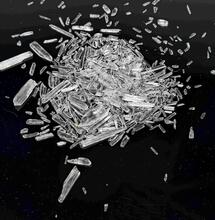Warm Weather, Wet Weed

With summertime in full swing, it is not easy to keep your pot dry enough to smoke
With summertime in full swing, it is not easy to keep your pot dry enough to smoke
Cannabis can be smoked, eaten or drunk, vaporized or applied topically. However, if your favorite method of consumption is to inhale it, the product needs to be dry enough to smoke or even vaporize. The best way to produce prime bud is to grow it in soil with organic nutrients, but that is not enough to ensure that your efforts are not wasted. High-quality weed is the stuff that is not only grown well, but that which has also dried, cured and stored properly. This can be difficult - or even impossible - during the hot, humid weeks of the summertime. Here we will discuss some easy options for both growers and smokers.
If Your Weed Is Wet, Then Wait!
Even if you decide to consume your pot in an edible form, it is best to properly process the weed before making green butter, cooking oil or ghee with it. Some producers of medibles have reported a higher percentage of contaminants, ranging from chlorophyll to residual nutrients or pesticides, being transferred into the end product when wet rather than dry marijuana or trim is used to make green butter or cooking oil, although the exact process used varies between manufacturers. Others disagree with this finding, though, as the vegetable matter becomes sodden due to the cooking/extraction process itself.
Those who prefer vaporization, or especially smoking, should take some extra steps to ensure that they are receiving as many cannabinoids as possible from their product, and thus should only use Cannabis that has reached a good level of dryness.
When marijuana is freshly harvested or has not yet finished its drying cycle, those attempting to consume it will be disappointed. Three main issues arise from consuming wet weed: the consumer will not experience the true impact of that particular strain, the flavor and scent will be harsh and, finally, a headache becomes a likely prospect.
Two main reasons that still-damp pot is not technically usable is because, firstly, the active drug ingredients in marijuana are not water-based and, secondly, it is difficult to light vegetable matter on fire. Drug products such as THC and CBD are not actually contained within the vegetable matter of female weed flowers; however, such matter must be thoroughly dried in order not to impede the transformation of the plant's phytocannabinoids into smoke or vapor.
Consuming Damp Marijuana Wastes Cannabinoids
The phytocannabinoids or active compounds in Cannabis plants are ensconced in oil-filled resin glands, known as trichomes, that coat the surfaces of female flower parts. Although hundreds of cannabinoids exist, no marijuana variety contains all of them. Rather, each strain contains a specific selection of cannabinoids that act in concert to present the unique effect of each strain, while various terpenes influence flavor, scent and effect (the latter of which occurs in an as-yet unknown way); isolating cannabinoids and consuming them alone will not provide anywhere near the same effect. What makes each pot variety so compelling - flavor, effect, scent, duration, strength - results from the magical potpourri of different cannabinoids combined in different ratios, with terpenes tweaking the potion. General cannabinoid levels are (relatively) controlled via strain selection and choosing the correct harvest time for that particular strain.
Additionally, the level of each cannabinoid changes throughout the drying process, meaning that a wet bud will contain different cannabinoids in different ratios than it will when properly dried, or if tested sometime during that transitional period. Ironically, for example, freshly-harvested pot that cannot yet be smoked contains the highest amount of THC that that particular bud will ever contain, which diminishes as the flowers dry and cure, due mostly to oxidation but also to metabolic action that does not occur when the plant is living. For example, cannabinolic acid (CBN acid), is one THC metabolite that results primarily from the exposure of trichomes to heat and light. CBN acid is largely considered to be a sort of anti-THC, as it tends to cancel out the euphoric, psychotropic effects of the latter (and CBN also causes many users to experience a headache) in favor of a more body-based, stoned feeling.
THC levels continue to fluctuate, even as the harvested plant completes non-enzymatic processes. While THC is degraded into CBN acid, CBD is broken down into THC acid. As Robert Connell Clarke explains in Marijuana Botany, "If the rate of THC biosynthesis exceeds the rate of THC breakdown, the THC level in the trichome rises; if the breakdown rate is faster than the rate of biosynthesis, the THC level drops." (p. 135)
If effect is important to you - and if it is not, why use marijuana at all? - then making sure that you do not consume moist ganja, thereby wasting both the high and your money, is essential.
Side-Note on Cannabinoid Percentages
A common misconception exists where people believe that percentages of cannabinoids are essential knowledge when selecting a strain; however, every bud from a single plant will provide slightly varying percentages, so you can imagine the variation between different plants of the same strain selected from the same grow room. Even clones will not provide a 100-percent match that is botanically accurate, and, as mentioned above, testing the same plant multiple times throughout its growth, flowering and drying cycles will present different results each time.
Furthermore, until recent years, no private entities were actively testing cannabinoid levels and offering public access. Test kits are currently available that will report cannabinoid percentages on samples of varying sizes; such kits may be used by medical patients, recreational users or growers of any experience level. However, extremely expensive scientific equipment and methodologies (e.g., high-performance liquid chromatography or gas chromatography) are required for scientifically accurate cannabinoid identification and potency testing. Such focused testing can also reveal the existence of mold, yeast, pathogens, residual nutrients, solvents and/or pesticides and other contaminants, especially when also utilizing liquid chromatograph mass spectrometry (LCMS).
None of this quality control matters, however, if the product that you are trying to smoke is still wet - even hash must be dry before it can be properly consumed.
Thus, there is no good reason to try to smoke wet Cannabis.
How To Determine the Dryness of Your Cannabis
In addition to monitoring your relative humidity levels in the grow room or drying area by regularly checking a hygrometer, the easiest method of ascertaining the moisture level in your weed is to simply locate a branch or stem within the bud and attempt to break it. If you can feel and hear the snap, then you can be relatively certain that the product is dry or nearly completely dry. If the stem bends but does not break and no bud easily separates from it, a lot of moisture remains in the plant matter. If your buds are crumbling to dust, they have been over-dried, which is often a result of 'flash' drying.
Scent is also often a good indication of moisture levels, as some strains dramatically change scent between harvesting and their dry point. If you do not have a lot of experience with different varieties and/or grow rooms or know your strain especially well, this method might not be a viable option for testing.
Color may assist some knowledgeable consumers, too, although this approach requires the same level of experience as the scent test. Freshly-harvested pot plants tend to be a brighter, more vibrant green, while those that have experienced at least a short drying period will show darker foliage. As the plant dries, the chlorophyl becomes desiccated and degrades, making both leaf and bud turn anywhere from dark green to nearly black (on some indica-dominant strains). Well-cured weed often appears golden to nearly brown, as the vegetable matter further dries and degrades - as happens during the tobacco drying process.
The benefits of the aforementioned indications is that they do not require consuming the product, although simply trying to smoke the weed is also an easy - yet wasteful - way to determine dryness. Smoke from wet weed is harsh and sharp-tasting; coughing is nearly unavoidable when smoking damp Cannabis. Test-drying and smoking your buds from just before harvest to any time during the drying and curing process is a good way to monitor cannabinoid levels and the progress of the product.
How To Properly Dry and Cure Marijuana
dsgsg
How To Quickly Dry Weed for Smoking But Not Quality ('Desperation Drying')
In spite everything that has already been covered in this article, there are situations in which quality is far less of a concern than simply being able to immediately smoke your stash. Although it is not advisable to flash-dry your pot, if you have nothing else to smoke, it is often difficult to wait until the product has reached its optimum dryness.
A simple method of quickly drying your weed is to place it in a container of some sort - glass is far superior to plastic or wood - that can expose it to a large amount of air. A glass bowl is a good choice, or a footed fruit bowl, because it allows you to elevate the buds in order to encourage and control the desired amount of air flow.
How to flash-dry your weed:
Select a glass bowl that is large enough to accommodate a flat, even layer of buds across the bottom. Place a coffee filter in the bottom of the bowl or container. Spread your ganja in a thin, even layer across the filter. Situate the bowl close enough to a fan or air conditioner that you can feel a gentle disturbance of the air when you place your hand above the bowl. If the air flow is too intense, place the container farther away and if you cannot feel any breeze, move it closer.
Once per day, gently agitate or flip the buds, maintaining an even layer across the coffee filter.
How NOT to flash-dry your weed:
Heat, light and humidity are the enemies of properly dried Cannabis. Even if you do not really care about quality, it is still not a good idea to flash-dry your weed in a haphazard fashion. Whether you bought a 'dime bag' or a couple of ounces, you do not want to waste your investment - or your high. Some enterprising youths in Ireland and the United Kingdom have been known to dry their weed in the microwave or on top of heaters and radiators. Neither is a good idea, as the high temperatures destroy all of the wonderful cannabinoids, both active and inactive but necessary. Too much air flow can also cause oxidation of the trichomes.
Light is an unsuspecting enemy of those wishing to at least dry, if not cure, their product. Light also encourages oxidation of the cannabinoids within the glandular trichomes of the female Cannabis flowers. If you must dry your weed at home, make sure to hang it in a cool, dry area that sees little traffic but maintains good air flow. You must artificially block out the light in your drying area if you cannot source a naturally dark space that also has good air flow. Some folks hang their weed
Do not underestimate the importance of air flow, which is necessary in order to exchange the gases expelled by the plant as it dries. Humidity is also something that needs to be strictly controlled (keep your drying space at around forty to sixty percent.) As tempting as it may be, resist the urge to hang your fresh buds or branches on a clothes line in the bathroom - that is, if it is a bathroom that people actually use. When a drying space is properly ventilated, stale, moist air leaves the area and is then exchanged with fresh, clean, dry air. This process prevents mold and mildew from taking hold and also allows the vegetative matter to properly complete the processes required to change a freshly-harvested, soggy bud into the dense, dry, tasty nuggets that are smoked and enjoyed.
Home Growers, Monitor Summertime Humidity Levels!
As the temperature and humidity outside rise, a similar effect takes place inside your house - and grow room.
While your plants progress through their life cycle, remember that the amount of humidity that they require for healthy development changes exponentially. When plants are just tiny seedlings or clones that are struggling to root, their humidity requirements range between ninety and a hundred percent. Generally, vegetating plants will be okay at levels between sixty and eighty percent, and flowering plants max out at a threshold of around sixty percent. Thus, tiny young plants need the most, while flowering plants require the lowest amount of humidity.
Too much moisture in the air can cause mold and mildew problems; once your buds and/or plants are rotting, there is not much that you can do to save them (with the exception of mild infections or specific types of pathogens). Although some indoor growers do use an air conditioner during warm springtime or summer grows, it should be noted that humidity and air temperature directly affect each other. This means that the drying action of an air conditioner in a grow room will drive down humidity levels - which is not necessarily a good thing.
However, if your drying room is adjacent to or built within your grow area, an easy solution is to try to aim the cool, dry air more towards the harvested plants that are hanging.
Wet Weed and Dry-Sieve Hash
Although methods of extracting hash with ice water or otherwise utilizing wet Cannabis in hash production is common, those preferring a more granular product often choose to manufacture dry-sieve hash. The results look and feel similar to kief or pollen hash but the quality is far cleaner and effect is much stronger and more efficient - in theory, at least.
Poor production, processing and handling techniques can ruin a batch of hash before it has even had a chance to dry or while it is drying. Using wet marijuana when making dry-sieve hash is not only counter-intuitive, but also incredibly stupid. The combination of waterlogged plant matter and whatever friction is applied in order to remove the trichomes results in a soggy, dark green mess.
Not only do the trichomes rarely separate into proper hash this way, but they will also likely be damaged during the hash-making process. In addition, the plant's green chlorophyl and any residual pesticides or nutrients may be released into any final product that you do manage to produce, which is why even some ice hash appears to be green, rather than golden (although lower-quality runs of ice hash generally lose their beautiful golden appearance as more runs are executed.)
Although many other methods of manufacturing Cannabis concentrates do not require the raw material to be dry, it is still important to store your wet weed properly in order to prevent various types of mold and mildew from contaminating your future hash yield.



